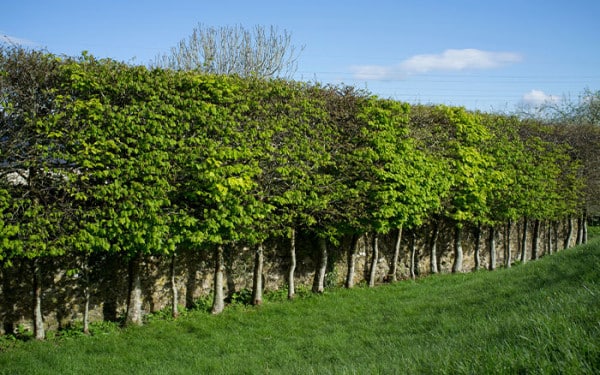Pleached trees are increasing in popularity once again. They’re a great way of getting privacy in the garden whilst not taking up lots of valuable floor space. Using evergreen types will guarantee structure and form all year round.
What are pleached trees?
Pleaching is the word that describes trees with long straight stems and a narrow upper square or rectangular framework of branches. They are often used to create walkways and tunnels. They’re also great for giving high level privacy from neighbours without casting a lot of shadow into the gardens.
They’re created by tying in and interweaving young, flexible shoots from the upper part of the tree onto a cane structure. Then the buds and lower branches below that framework are all removed.
The technique of pleached trees or ‘hedges on stilts’ was used back in the Medieval times. It was used to create walkways for shade. They were also used to line the gardens of stately homes back in the 17th and 18th centuries in Europe, specifically France and Italy.

Trees to choose
There are many different trees that can be chosen to adapt to this technique. There are both evergreen and deciduous types to choose from. Some evergreen choices are cherry laurel and magnolia grandiflora. On the other hand, a classic deciduous choice is hornbeam.
It’s quite an easy thing to do if you choose the right tree. Lime, hornbeam, ash, and beech are the easiest trees to pleach.
Crab apples as well as domestic apples and pear trees also look good pleached especially during the spring when they’re full of blossom.

When to plant and prune
The best time of the year to tie in new shoots is during the summer months.
After a few years the tree shoots should have covered and been tied in to the whole of the bamboo framework. After this time, all that needs to be done is to prune the excess growth of those shoots to keep the trees pleached framework shape.
Mature pleach trees can be expensive to buy. So, it’s well worth having a go yourself. Bear in mind that it can take about 6 years for the upper shoots to have fully covered the framework. But it’s well worth the wait, as you’ll have the pride and joy of knowing you’ve created something special as well as having saved the money too.
Pleached espalier trees
Go one step further and have pleached espalier trees for a decorative yet productive addition. They’re a fantastic way of saving space but still producing fruit such as apples and pears.
Once again, these are great for privacy, as well as blooming beautiful flowers that are attractive to pollinators.
Unlike traditional ones, espalier types have branches that are trained in lines along canes so there’s sufficient room for the fruit to grow.


Leave A Comment